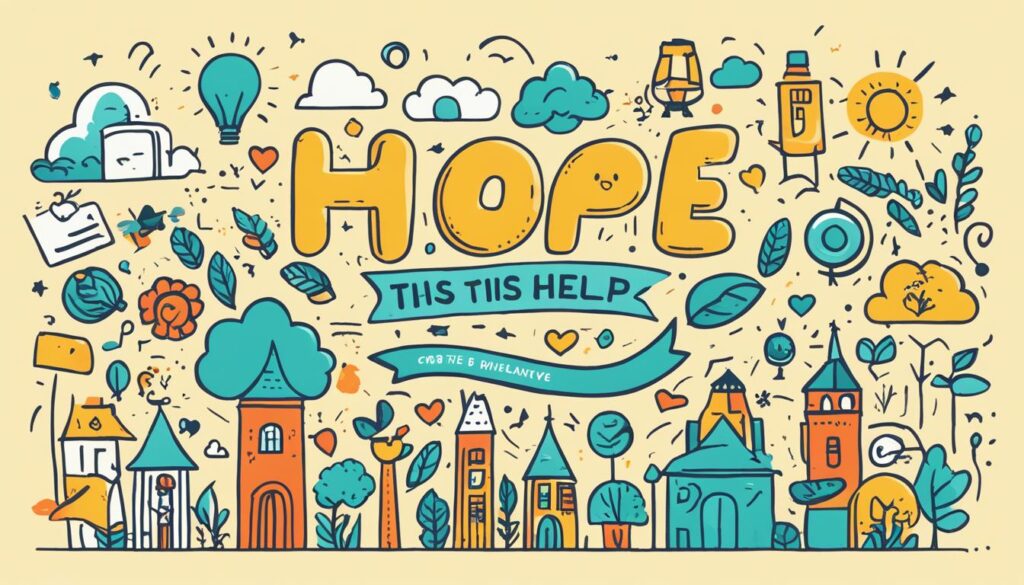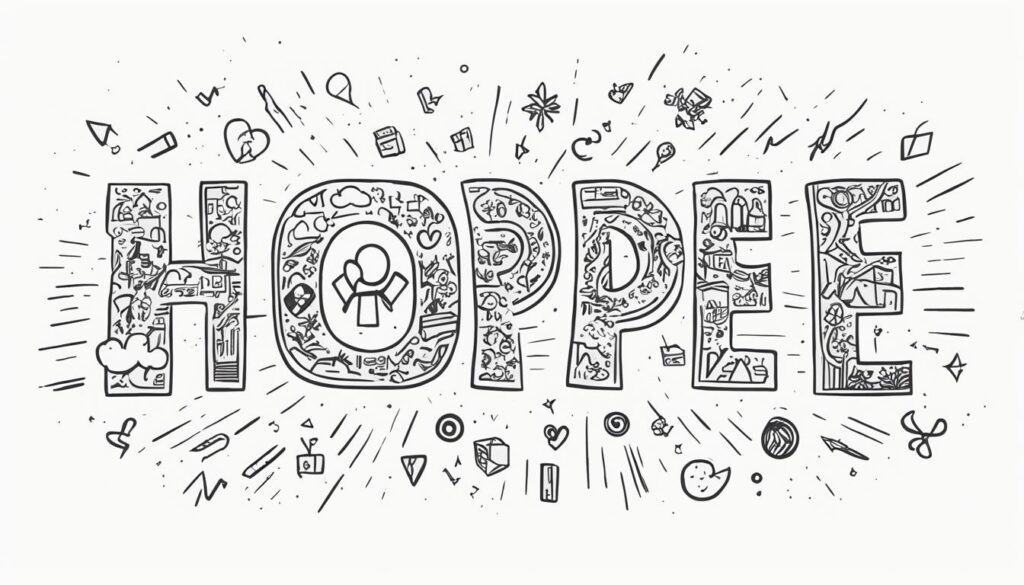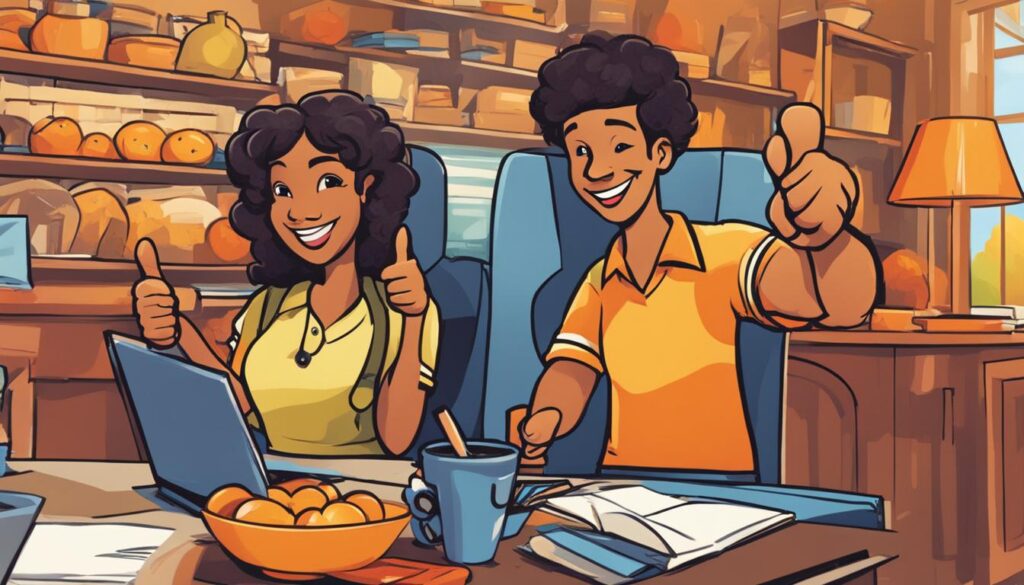Are you offering someone help but unsure whether “hope this helps” is the best thing to say? You might want to come across as slightly more confident or professional by using a different saying. This article will dive into what to say instead of “hope this helps” and provide a variety of helpful expressions.
Key Takeaways:
- Explore alternative phrases for “hope this helps”
- Find helpful expressions to convey confidence and professionalism
- Discover different ways to express assistance
- Utilize variations of “hope this helps” for different contexts
- Expand your repertoire of customer service phrases
Other Ways to Say “Hope This Helps”
In the search for meaningful and impactful expressions, there are various alternatives to the common phrase “hope this helps.” By diversifying your language, you can better convey your intentions and foster stronger connections with others. Below are poetic alternatives that will leave a lasting impression:
- I hope this information is useful: Elevate your words by emphasizing the value and usefulness of the provided information.
- Hope this works for you: Express optimism and convey that your contribution will lead to a positive outcome.
- This should work: Instill confidence by affirming that your suggestion is a reliable solution.
- This should help: Offer reassurance that your support will alleviate concerns and provide assistance.
- Do you need anything else from me? Demonstrate your readiness to go above and beyond, ensuring all needs are met.
- I hope this is everything: Indicate thoroughness and completeness in your assistance.
- I’m sure that’s enough: Display confidence in your provision, assuring the recipient that your help is sufficient.
- Is that enough to help? Confirm your understanding and prompt further clarification, allowing you to tailor your assistance accordingly.
- Will that be enough? Show consideration for the recipient’s expectations and inquire if your aid meets their requirements.
- Does this help? Seek validation and encourage open communication to ensure your support aligns with their needs.
- If I can do anything else to help, let me know: Extend a genuine offer of continued assistance, demonstrating your commitment to their success.
- I hope you find this useful: Express your desire for the recipient to benefit from the information or aid provided.
- I hope that’s everything: Convey attentiveness by expressing your hope that you have addressed all the recipient’s concerns.
By incorporating these alternative expressions into your interactions, you can leave a lasting impact and create more meaningful connections. Remember, choosing the right phrase depends on the context and relationship with the recipient. Embrace the power of language and elevate your communication to new heights.
“I Hope This Information Is Useful” (Formal)
“I hope this information is useful” is a great formal alternative to “hope this helps.” It is more concise and shows that you are providing information to help someone. This phrase can be used in formal emails as part of your closing statement to sound more professional and knowledgeable.
An example of using this phrase in an email could be:
Dear Patricia,
There are still a few ways we can sort this out. Most of them have been covered in the attachment below.
I hope this information is useful,
Derek
By using this phrase, you are conveying your intention to assist while acknowledging the value of the information you’ve shared. It adds a polite touch to your communication and ensures that the recipient understands the significance of the provided details.
Now, let’s take a closer look at other ways to express the same sentiment and make your interactions even more impactful.
“Hope This Works for You” (Informal)
“Hope this works for you” is a delightful and informal alternative to the familiar phrase “hope this helps.” This expression adds a touch of conversational charm when offering assistance to friends and family members. It exudes a genuine, friendly tone that connects on a personal level. However, it’s important to note that this phrase may not be suitable for formal emails or professional settings where a more polished tone is required.
Imagine a scenario where you’re helping a close friend troubleshoot a technical issue:
I’ve tried my best to solve the problem for you. Hope this works for you because I’m not able to stick around for much longer!
Or picture yourself reassuring a family member about a favor you’re doing for them:
I really hope this works for you. I don’t have any other ideas if this isn’t good enough!
By embracing this warm and informal phrase, you can foster a relaxed and comfortable tone in your interactions. Keep in mind that it’s essential to adapt your language based on the context and formality of the situation.
Explore a Visually Engaging Table to Highlight the Informal Alternatives for “Hope This Helps”:
| Informal Alternatives for “Hope This Helps” |
|---|
| Hope this works for you |
| I surely hope this is satisfactory |
| If this does the trick for you, let me know |
| Wishing this solves your problem |
| Let’s hope this gets the job done |
Each alternative captures the essence of “hope this helps” in an informal, conversational manner. Use these phrases to add a personal touch and engage with your loved ones or close acquaintances in a warm and friendly way. Remember, these expressions are best suited for casual conversations and should be adapted according to the context.
Is it Correct to Say “Hope This Helps”?
When it comes to expressing support and assistance, many of us default to the phrase “hope this helps.” Although it is acceptable in spoken English and casual conversations, it may not be the most appropriate choice in formal emails or business contexts. To ensure clear communication and maintain a professional tone, it is important to consider alternative variations of this expression.
An option to consider is “I hope this helps,” as it maintains the same meaning but adds a personal touch. By adding the pronoun “I,” you emphasize your direct involvement in providing assistance, showing a genuine desire to be of help.
Another alternative is to use “Hope that helps” instead. This phrase shifts the focus from the speaker to the recipient, acknowledging their needs and placing an equal emphasis on their satisfaction.
Using the Correct Tense and Pronoun
When using these alternative phrases, it is crucial to pay attention to the correct tense and pronoun choice to ensure accurate and effective communication.
In the present tense, use “helps” as it aligns with the present action. For example, “I hope this information helps you find what you’re looking for.”
If referring to a past action, use “helped.” For instance, “I’m glad that helped you resolve the issue.
Furthermore, use appropriate pronouns such as “this,” “that,” or “it” depending on the context. For instance, “I hope this advice is beneficial” or “Hope that clarifies any confusion.”
“Hope this helps” is correct in spoken English but may not be the most professional choice in formal emails or business contexts.
Alternatives to “Happy to Help”
In the realm of customer service, the phrase “happy to help” has become a ubiquitous expression. However, its frequent usage can make it sound impersonal or cliché. As a conscientious customer support professional, it’s essential to have a repertoire of alternative phrases that can effectively convey your willingness to assist. Here are some alternative phrases for “happy to help” that can help add a personal touch to your interactions:
- I’m glad for the opportunity to help you today: This phrase conveys a genuine sentiment of gratitude for the customer allowing you to provide assistance.
- We’re here for you whenever you need us: Assuring customers of your availability and ongoing support fosters a sense of trust and reliability.
- It would be my pleasure: By emphasizing the personal satisfaction derived from helping customers, this phrase elevates the level of service provided.
- You got it: This casual yet friendly phrase acknowledges the customer’s request and implies immediate action.
- Not a problem: By assuring the customer that their request is not burdensome, this phrase instills confidence and reassurance.
- Don’t hesitate to reach out: Encouraging customers to contact you further establishes an open line of communication and a willingness to provide ongoing support.
- At your service: This classic phrase conveys the message that you are dedicated to fulfilling the customer’s needs.
- I’d be more than willing to assist: By expressing a strong willingness to go above and beyond, you convey a proactive and customer-centric approach.
Adopting these alternative phrases allows you to break free from the commonplace and inject a personal touch into your customer interactions. Taking the time to choose the right words can make a significant impact on customer satisfaction and loyalty.
Remember, the ultimate goal is to make customers feel heard, valued, and genuinely cared for. Explore these alternative expressions and find the ones that resonate with your authentic style of customer service.
“I’d Love to Help”
When it comes to providing exceptional customer service, expressing genuine interest and enthusiasm can make all the difference. That’s why I’d love to introduce you to a powerful alternative to the commonly used phrase “happy to help” – “I’d love to help”. By simply switching the word “happy” with “love,” this expression conveys a deeper sense of eagerness and motivation to assist.
The phrase “I’d love to help” brings a touch of warmth and sincerity to customer interactions. It lets your customers know that you genuinely care about their success and are fully invested in finding the best solution for their needs. This personal and engaging approach can create a more positive and memorable experience for both you and your customers.
“The true beauty of customer service lies in the love and dedication we put into every interaction.”
Using “I’d love to help” demonstrates that you are not just fulfilling a task but actively seeking ways to go above and beyond for your customers. It shows empathy and a willingness to understand their unique challenges, fostering a stronger connection and trust.
Whether you’re providing technical support or answering inquiries, incorporating “I’d love to help” into your customer service repertoire adds a touch of personalization and authenticity. It elevates the customer experience from a transactional encounter to a meaningful interaction.
So, the next time you’re in a customer service situation, consider using “I’d love to help” as your go-to phrase. Let your eagerness shine through and create an experience that your customers will truly appreciate and remember.
Customer Testimonial:
“I reached out to the customer service team, and they responded with such kindness and enthusiasm – it was evident that they genuinely loved helping. It made such a difference in my overall experience with their company!” – John Smith
Remember, building strong customer relationships is about more than just providing assistance; it’s about making customers feel valued, understood, and cared for. By embracing the phrase “I’d love to help,” you can elevate your customer interactions to a new level of excellence.
Certainly
“Certainly,” a brief and concise response, is an excellent alternative to the commonly used phrase “happy to help.” It conveys a sense of attentiveness and readiness to support the customer, particularly when they are in a hurry and seeking a fast solution.
When a customer reaches out with a problem or request, responding with “Certainly” assures them that their issue has been heard and that you are prepared to provide the necessary assistance. This brief but powerful word acknowledges their needs and sets the tone for a positive interaction.
By using “Certainly,” you demonstrate your commitment to resolving the customer’s concerns swiftly and effectively. It also conveys confidence, assuring the customer that you are capable of addressing their needs.
“Certainly,” I respond, my voice filled with assuredness. “I understand your situation, and I am ready to assist you in finding a solution.”
Remember, a brief response can go a long way in customer service. Utilizing “Certainly” allows you to acknowledge the customer’s inquiry promptly while maintaining a sense of professionalism and courtesy.
| Pros | Cons |
|---|---|
| Conveys attentiveness and readiness to support | May come across as too formal in certain contexts |
| Demonstrates commitment and confidence | May not work for all customer service scenarios |
| Creates a positive tone for the interaction | Requires contextual awareness and appropriate use |
“It Would Be My Pleasure”
Alternative to happy to help, confident customer service
When customers find themselves in frustrating or stressful situations, it is crucial to provide them with a sense of reassurance and confidence. As a customer service professional, one way to achieve this is by using the phrase “It would be my pleasure” to convey your commitment to resolving their issues effectively.
This alternative to the commonly used phrase “happy to help” not only showcases your confidence but also exhibits a genuine desire to assist customers in the best possible way. By expressing that it would be your pleasure to help, you make customers feel valued and assure them that you are fully capable of addressing their concerns.
“It would be my pleasure to assist you in any way I can. Please let me know the details of the issue you are facing, and I will do everything in my power to resolve it.”
This phrase goes beyond a standard response and creates a personal connection with customers, fostering trust and satisfaction. When customers feel supported and confident in your abilities, their overall experience improves, and they are more likely to have a positive impression of your brand.
In summary, by using the phrase “It would be my pleasure,” you demonstrate your alternative approach to happy to help while ensuring confident customer service. This expression serves as a powerful tool to enhance customer interactions and contribute to a more successful and fulfilling customer support experience.
“You Got It”
When it comes to providing excellent customer service, empowering the customer is key. One way to do this is by using the phrase “You got it.” This casual alternative to “happy to help” acknowledges the customer’s needs and assures them that you are capable of fulfilling them.
The phrase “You got it” creates a sense of confidence and trust, letting the customer know that they can rely on you to assist them with whatever they need. It conveys a friendly and approachable tone, making it perfect for more informal interactions or with customers you have already established rapport with.
By using “You got it,” you are not only showing your willingness to help, but also empowering the customer to ask for assistance. It sends a message that their needs are important and that you are here to support them throughout their journey.
Remember, the customer’s satisfaction and success are your top priorities, and using empowering phrases like “You got it” can make a significant difference in their overall experience. So the next time a customer reaches out for help, respond with confidence and let them know that they have your full support. “You got it.”
“Not a Problem”
“Not a problem” is an alternative phrase that can be used in place of “happy to help.” It conveys a sense of reassurance and willingness to assist. However, it is important to use this phrase with caution. It is best suited for smaller tasks or requests that are relatively easy to fulfill. When dealing with more complex issues, it is advisable to choose a response that acknowledges the seriousness of the situation.
Using “not a problem” can create a friendly and approachable tone in customer interactions. It suggests that you are accommodating and ready to address any concerns. However, some customers may perceive this phrase as not taking their issue seriously enough. It is crucial to gauge the customer’s needs and the complexity of the problem before using this expression.
Potential Situations to Use “Not a Problem”
“Not a problem” can be used in a variety of customer service scenarios. Here are some examples:
- When a customer requests a minor adjustment or clarification
- When assisting a customer with a simple troubleshooting task
- When fulfilling a straightforward product or service request
By using “not a problem” appropriately, you can maintain a positive and helpful conversation with customers. It is important to ensure that your words convey both sincerity and competency, allowing customers to feel valued and supported throughout their interactions.
| Pros | Cons |
|---|---|
| – Conveys willingness to assist | – May not be suitable for complex issues |
| – Creates a friendly and approachable tone | – Some customers may perceive it as not taking their issue seriously enough |
| – Can be used for minor tasks or requests |
Conclusion
As we conclude this article, it is evident that having a diverse range of alternative phrases in your communication toolkit is crucial when trying to convey a personalized and genuine service experience to customers. Instead of relying solely on the overused “hope this helps,” consider using expressions that can keep conversations fresh and show your ongoing investment in solving customers’ problems.
By choosing the appropriate phrase based on the context and formality of the interaction, you can make a significant impact on the customer’s perception of your professionalism and expertise. Remember, providing exceptional customer service involves more than just the words you use; it’s about showing empathy, understanding, and a sincere desire to assist.
In summary, let’s recap some of the alternative phrases for “hope this helps” that we’ve explored in this article. You can use phrases like “I hope this information is useful,” “Hope this works for you,” or “If I can do anything else to help, let me know.” These variations will not only elevate your communication but also create stronger connections with your customers.
In conclusion, it’s time to leave behind generic and repetitive phrases and embrace a more personalized approach to customer assistance. So go ahead, try out these alternative expressions, and witness the positive impact they can have on your customer interactions.
FAQ
What are some alternative phrases for “hope this helps”?
Some alternative phrases for “hope this helps” include “I hope this information is useful,” “Hope this works for you,” “This should work,” and “This should help.” There are many variations and alternative expressions that can be used to convey the same meaning.
When should I use the phrase “I hope this information is useful”?
“I hope this information is useful” is a great formal alternative to “hope this helps.” It can be used in formal emails or professional environments to sound more professional and knowledgeable. This phrase shows that you are providing information to help someone, and it can be used as part of your closing statement in an email.
Is “hope this works for you” an appropriate phrase to use in all situations?
“Hope this works for you” is a great informal synonym for “hope this helps,” but it is not recommended for formal emails or business contexts. This phrase is more conversational and can be used when providing assistance to friends or family members. However, it may not convey a professional tone in formal settings.
Can I still use “hope this helps” in spoken English?
Yes, “hope this helps” is correct in spoken English. Variations of the phrase, such as “I hope this helps” or “hope that helps,” can also be used. It is important to use the appropriate tense and pronoun choice based on the context.
What are some alternatives to “happy to help” in customer service?
Some alternatives to “happy to help” in customer service include “I’m glad for the opportunity to help you today,” “We’re here for you whenever you need us,” and “It would be my pleasure.” These phrases can help provide a more personalized and genuine service experience for customers.
How does using “I’d love to help” make interactions more personal and engaging?
By switching the word “happy” with “love,” the phrase “I’d love to help” expresses a stronger eagerness and motivation to assist. This change conveys a sincere interest in the customer’s success and can help make interactions more personal and engaging.
When is “certainly” a good response to use in customer service?
“Certainly” is a brief and concise response that shows the customer you have listened to their problem and are ready to provide support. This phrase is effective in situations where customers may be frustrated or stressed about a problem, as it demonstrates confidence in your ability to troubleshoot and helps diffuse any overwhelming feelings the customer may have.
What does using “it would be my pleasure” convey in customer service?
Using the phrase “it would be my pleasure” in customer service conveys a confident and helpful demeanor. It assures the customer that you are capable of providing whatever they need and empowers them to ask for help. This phrase can be used in a more casual setting, particularly with customers you have already established rapport with.
How can I use “you got it” as an alternative to “happy to help”?
“You got it” is a casual alternative to “happy to help” that can be used to empower the customer. This phrase signifies your willingness to assist and assures the customer that their request will be taken care of. It is important to use this phrase in appropriate contexts, particularly with customers you have a more informal relationship with.
Can “not a problem” also be used as an alternative to “happy to help”?
“Not a problem” can be used as an alternative to “happy to help,” but it should be used with caution. This phrase is best suited for smaller tasks or requests that are relatively easy to fulfill. However, be mindful that some customers may perceive this phrase as not taking their issue seriously enough.
No section 12, there is no conclusion.
Source Links
- https://wordselector.com/other-ways-to-say-hope-this-helps/
- https://www.zendesk.com/blog/happy-to-help/
- https://blog.hubspot.com/service/happy-to-help














